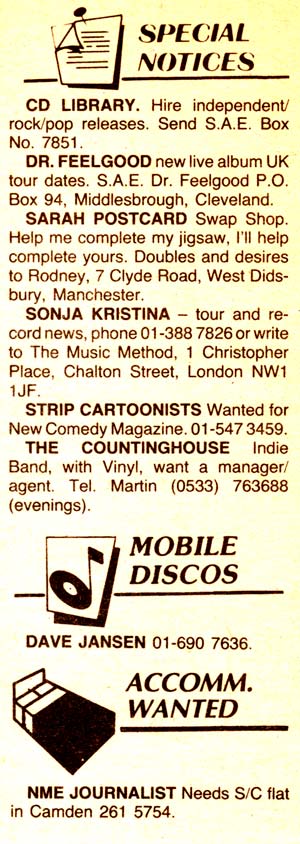 Obviously the thinking behind the Severn Beach Line postcards that were included with SARAHs 21 to 30 was to make important political points about Capitalism and public transport. But they also unwittingly provided an opportunity for lonely hearts – an indie-Tinder, if you will – as this cutting from the NME classifieds from 1990 amply demonstrates: lovelorn Rodney of West Didsbury is seeking someone to help him “complete his jigsaw”, and I think we all know what he means by that – “doubles and desires” is what he’s euphemistically after, the saucy devil. Well, I hope you found true love eventually, Rodney; or at least managed to get rid of some of those spare clocktowers. I wonder if that NME journalist ever found a flat in Camden?
Obviously the thinking behind the Severn Beach Line postcards that were included with SARAHs 21 to 30 was to make important political points about Capitalism and public transport. But they also unwittingly provided an opportunity for lonely hearts – an indie-Tinder, if you will – as this cutting from the NME classifieds from 1990 amply demonstrates: lovelorn Rodney of West Didsbury is seeking someone to help him “complete his jigsaw”, and I think we all know what he means by that – “doubles and desires” is what he’s euphemistically after, the saucy devil. Well, I hope you found true love eventually, Rodney; or at least managed to get rid of some of those spare clocktowers. I wonder if that NME journalist ever found a flat in Camden?
Category Archives: Trains and Postcards
NME “Fred Fact” on Sarah 21-30 7″ labels (Fred Dellar, NME)
Mojo misses the point
 You wouldn’t think it would be possible to misunderstand us to such a large extent in such a small number words, but obviously Mojo‘s whole raison d’être is to completely miss the point of everything about pop music, so I guess I shouldn’t be too surprised. This is from a feature called Nuggets which judges records according to how much idiots are prepared to pay for them. And he’s right, of course… if only we’d put as much effort into making the records good as we did into making them collectable, we wouldn’t have been forced to give up at SARAH 100 and take out hugely expensive adverts explaining that the label was no longer financially viable. Noah’s Ark is fantastic, by the way – as music, I mean, not as an investment opportunity.
You wouldn’t think it would be possible to misunderstand us to such a large extent in such a small number words, but obviously Mojo‘s whole raison d’être is to completely miss the point of everything about pop music, so I guess I shouldn’t be too surprised. This is from a feature called Nuggets which judges records according to how much idiots are prepared to pay for them. And he’s right, of course… if only we’d put as much effort into making the records good as we did into making them collectable, we wouldn’t have been forced to give up at SARAH 100 and take out hugely expensive adverts explaining that the label was no longer financially viable. Noah’s Ark is fantastic, by the way – as music, I mean, not as an investment opportunity.
Temple Meads postcards (SARAHs 21-30)
 Many people, and not just those who got four clocktowers in SARAHs 21-24, were confused by our postcards. But it’s pretty simple: Temple Meads is the last stop on the Severn Beach line, the line’s other ten stations are on the centre labels, and the postcards were put in randomly to annoy collectors. (That’s Brunel’s original terminus to the left of the car park, by the way; I think it closed when people realised the platforms were nowhere near the tracks.)
Many people, and not just those who got four clocktowers in SARAHs 21-24, were confused by our postcards. But it’s pretty simple: Temple Meads is the last stop on the Severn Beach line, the line’s other ten stations are on the centre labels, and the postcards were put in randomly to annoy collectors. (That’s Brunel’s original terminus to the left of the car park, by the way; I think it closed when people realised the platforms were nowhere near the tracks.)
